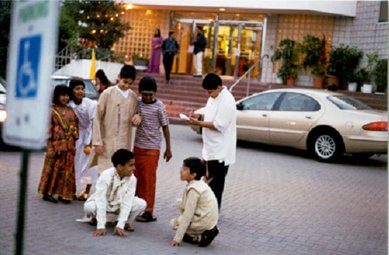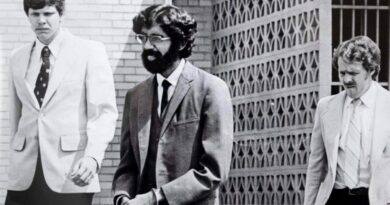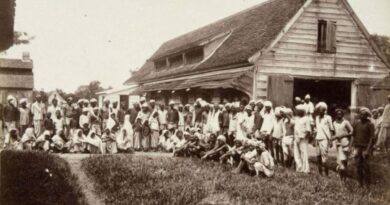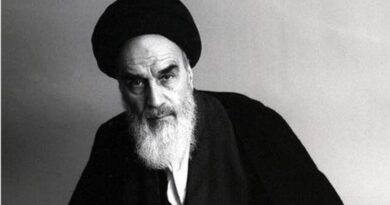Home away from the homeland
-before the new Millennium
I produced photographic research on the Indian Diaspora during my international travel, titled, Home away from the homeland – before the new Millennium.

The theme of this exhibition is concerned with the experience of various generations of Indians living abroad who try to retain aspects of the life they remember before they left India. After one or two generations, Indians seem to find themselves in a time warp that relates to an India that no longer exists, except in the memory of their grandparents. In some ways, their way of living Indian culture is more traditional than is possible in contemporary India. Thus, a body of work is created through photography on ‘Home away from homeland.’
The word ‘Indian’ is used broadly and includes Pakistanis, Bangladeshis, and Sri Lankans. These images focus on the social, commercial, cultural, religious, and day-to-day activities of Indians and observe the delicate blending of different cultures. The intention was to capture what Indians have adapted from the West and vice-versa.
“I chose this theme because, as an Indian abroad myself,
I share the concerns and experiences of my fellow exiles.
I am both an observer and a subject.”
The research travelled around England, Scotland, Germany, the USA, and Canada to compare the differences and similarities between the Indians in different parts of the West.
In 1961, the local authorities of Leicester in England and Krefeld in Germany declared the cities “twin” towns. Leicester has the largest Indian population in Europe. Hence, choosing Krefeld in Germany was to investigate the Indian Community in Leicester’s “twin” town. Furthermore, to compare the lifestyles of the ‘Indians’ in different parts of the West, a study was then conducted on the East coast of the USA and Canada.

Alongside the photography collection, the researched paper caters to various audiences. For example, for those Indians who cannot travel abroad, it will be an awareness-raising project that expresses the significance of their community in foreign lands. It could also target the population of different countries to inform them about the Indians who live amongst them and their distinctive culture.
A new flavour to this project is the images taken in India of the Non-Resident Indians (NRI). This exhibition establishes a visually recorded history of Indians living abroad before the Millennium.

Home away from the homeland (AKA: An Indian Abroad) has numerous international accolades and invited to many prestigious galleries around the World:
Who is an NRI?
A non-resident Indian (NRI) is an Indian citizen who has migrated to another country, a person of Indian origin born outside India, or a person of Indian origin who resides outside India. Other terms with the same meaning are overseas Indian and expatriate Indian. In common usage, this often includes Indian-born individuals (and people of other nations with Indian blood) who have taken the citizenship of other countries.
What is a PIO?
A Person of Indian Origin (PIO) is usually a person of Indian origin who is not a citizen of India. However, to issue a PIO Card, the Indian Government considers anyone of Indian roots up to four generations removed to be a PIO.
Who is an OCI?
In 2005, the Indian Government introduced the “Overseas Citizenship of India (OCI)” scheme to allow a limited form of dual citizenship to Indians, NRIs, and PIOs for the first time since independence in 1947. As a result, the PIO Card scheme will phase out on 31 December 2022 in favour of OCI.

SELECT INDIAN DIASPORA FACTS
India has the largest Diaspora in the world & as per the Ministry of External Affairs, there are 3.2 Crores or 32 million Non-Resident Indians (NRIs) and Persons of Indian Origin (PIOs) residing outside India.
Indians in the U.K.
The Indian emigrant community in the United Kingdom is now in its third generation. As an immigrant group, people of Indian origin have been remarkably successful. Indians in the U.K. are the largest community outside of Asia percentage-wise and the second-largest population-wise, only surpassed by the United States.
Indian culture refers to an “exotic” influence in films like My Beautiful Launderette within broader British culture. Still, it is now increasingly a familiar feature in films like Bend It Like Beckham.
Today, Indians comprise about 1.4 million people in the U.K., making them the single largest visible ethnic minority population. These statistics include people born in the U.K. who are of Indian origin and Indians who have migrated to the U.K.
Indians in Germany.
Indians makeup around 0.2% of the German population and approx. the population of Indians in Germany as of 2021 is 200000. Persons of Indian Origin in Germany are approx. 42,500. Indian Expats have recently immigrated especially information technology professionals. As of 2022, about 150000 NRIs live in Germany. Most of them live in the regions of Berlin, Munich, Hamburg, and Frankfurt. Indian Students are also in good numbers in Germany.
Indians in Canada.
Indians makeup around 4% of the Canadian population and approx. the population of Indians in Canada in 2022 is 16 Lakhs. As per the Ministry of External Affairs report (2018), 1,689,055 (16.89 Lakhs) Indians reside in Canada. The term “East Indian” or Indo-Canadian is most commonly associated with people of Indian origin. However, the term Indian in Canada widely refers to the Aboriginal Canadians and continues to describe them, causing much confusion. In addition, the term Indian is also occasionally applied to people from the Caribbean (West Indians), also called Indo-Caribbean. The first known Indian settlers in Canada were Indian army soldiers who had passed through Canada in 1897 on their way back home from attending Queen Victoria’s Diamond Jubilee celebration in London, England.
Indians in the U.S.
Indian immigration to North America started as early as the 1890s. A Sikh-Canadians community has existed in Abbotsford, BC, Canada, for over 100 years. The Hindus from India started to settle after the Government built the first Mandir (Hindu temple). Many Sikhs living in the U.S. would often visit their homes in India and share their experiences. The stories would encourage the Hindus to move to the U.S. and live there.
In 1889 the first Hindu family arrived in America; the Government built a Mandir for the family, attracting more Hindu immigrants. Soon after, there were many Mandirs to be found around the country. Sikhs were not allowed to build a temple as the Government believed that Sikhism was born from Hinduism. Hence the Sikhs would have to either pray at the Mandirs or not. The real reason was the Government did not want to use any more money on places of worship. More than 75% of the Sikhs prayed at the Mandirs, but about one hundred refused as they wanted to retain their religion within the Gurdwara (Sikh temple), so they protested for almost 22 years.
Finally, in 1911, the first Gurdwara was built not in America but in Canada because the American Government was busy with the war in Japan and Europe. Today there are very few Gurdwaras in America and many in Canada. The first Gurdwara on South Fraser Way in Abbotsford is the oldest Sikh temple in North America (1911). Emigration to the U.S. also started in the late 19th and early 20th century, when Sikhs arriving in Vancouver found that they were subjects of the British Empire did not mean anything in the Empire (Canada) itself, and they faced blatant discrimination.
Some of these pioneers entered the U.S. or landed in Seattle and San Francisco as the ships that carried them from Asia often stopped at these ports. Most of these immigrants were Sikhs from the Punjab region. They were referred to in the U.S. as Hindus (due to a common American misconception that all Indians are Hindus and that this term distinguished immigrants from Native Americans, who were also called Indians).
Due to a restriction on immigration for the Indian women, banned under the racially discriminatory immigration laws passed by the U.S. government in 1917 at the behest of California and other States in the West, saw a large influx of Chinese, Japanese and Punjabi immigrants during and after the gold rush.
Due to a restriction on immigration for the Indian women, banned under the racially discriminatory immigration laws passed by the U.S. government in 1917 at the behest of California and other States in the West, saw a large influx of Chinese, Japanese and Punjabi immigrants during and after the gold rush.
As a result, many of these men married Mexican women in California. Many of these families settled down in the Central Valley in California as farmers, who continue farming to date. But unfortunately, it deprived these early immigrants of voting rights, family reunification, and citizenship.
In 1923 the U.S. Supreme Court in the United States v. Bhagat Singh Thind case ruled that people from India (at the time, British India, e.g., South Asians) were aliens ineligible for citizenship and became a citizen a few years later in New York. Bhagat Singh Thind was a Sikh from India who settled in Oregon and earlier experienced rejection in Oregon. However, after World War 2 came an approval for family reunification for people of non-white origin. After being banned for almost half a century, they now got the right to vote. As a result, many men who arrived before the 1940s could finally bring their families to the U.S., and most settled in California and other West coast states.
Another wave entered the U.S. in the ’50s, ’60s, ’70s, and ’80s. Many of them were Sikhs joining their family members under the new color-blind immigration laws and professionals or students from India. The Cold War created a need for engineers in the defense and aerospace industries, many of whom came from India. By the late 1980s and early 1990s, Gujarati and South-Indian immigrants outnumbered Sikhs or Punjabis as new arrivals, though all communities had pretty much even representation in overall Indian-American numbers.
The most recent and probably the most significant wave of immigration occurred in the late 1990s and early 2000 during the Internet boom. Today, Indians in the U.S. are now one of the largest groups of Indian Diaspora, numbering about 4,460,000. In contrast to the previous Indians who entered the U.S. workforce as taxi drivers, laborers, farmers, or small business owners, the latest set was very successful financially thanks to the hi-tech industry and are thus probably the most well-off community of immigrants.
By Tushar Unadkat
Reference material:
ons.gov.uk/census/index.html | census.gov | statcan.ca/census-recensement/index-eng.cfm | indiandiaspora.nic.in | en.wikipedia.org | findeasy.in





Hello, Neat post. There is an issue along with your website in web explorer, could test thisK IE nonetheless is the market leader and a huge section of folks will leave out your magnificent writing because of this problem.
Top site ,.. amazaing post ! Just keep the work on !
I am very happy to read this. This is the type of manual that needs to be given and not the accidental misinformation that is at the other blogs. Appreciate your sharing this best doc.
This actually answered my problem, thank you!
Wow, fantastic blog layout! How long have you been blogging for? you made blogging look easy. The overall look of your site is excellent, let alone the content!
I really like your writing style, great info, appreciate it for putting up :D. “You can complain because roses have thorns, or you can rejoice because thorns have roses.” by Ziggy.
Some really interesting info , well written and broadly speaking user friendly.